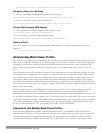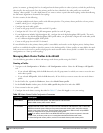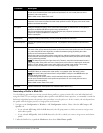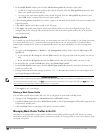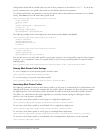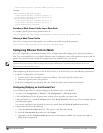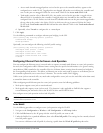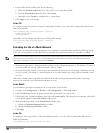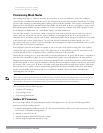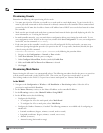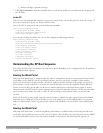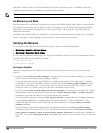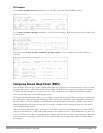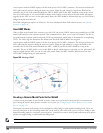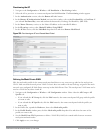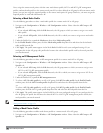
max-request-retries 10000
bootstrap-threshold 5000
Provisioning Mesh Nodes
Provisioning mesh nodes is similar to thin APs; however, there are some key differences. Thin APs establish a
channel to the controller from which they receive the configuration for each radio interface. Mesh nodes, in contrast,
get their radio interfaces up and running before making contact with the controller. This requires a minimum set of
parameters from the AP group and mesh cluster that enables the mesh node to discover a neighbor to create a mesh
link and subsequent channel with the controller. To do this, you must first configure mesh cluster profiles for each
mesh node prior to deployment. See “Mesh Radio Profiles” for more information.
On each radio interface, you provision a mode of operation: mesh node or thin AP (access) mode. If you do not
specify mesh, the AP operates in thin AP (access) mode. If you configure mesh, the AP is provisioned with a
minimum of two mesh cluster profiles: the “default” mesh cluster profile and an emergency read-only recovery profile,
as described in the section “Mesh Clusters”. If you create and select multiple mesh cluster profiles, the AP is
provisioned with those as well. If you have a dual-radio AP and configure one radio for mesh and the other as a thin
AP, each radio is provisioned as configured.
Each radio provisioned in mesh mode can operate in one of two roles: mesh portal or mesh point. You explicitly
configure the role, as described in this section. This allows the AP to know whether it uses the mesh link (via the
mesh point/mesh portal) or an Ethernet link to establish a connection to the controller.
During the provisioning process, mesh nodes look for a mesh profile that the AP group and AP name is a member of
and stores that information in flash. If you have multiple cluster profiles, the mesh portal uses the best profile to
bring-up the mesh network. Mesh points in contrast go through the list of mesh cluster profiles in order of priority to
decide which profile to use to associate themselves with the network. In addition, when a mesh point is provisioned,
the country code is sent to the AP from its AP name or AP group along with the mesh cluster profiles. Mesh nodes
also learn the recovery profile, which is automatically generated by the master controller. If the other mesh cluster
profiles are unavailable, mesh nodes use the recovery profile to establish a link to the master controller; data
forwarding does not take place.
NOTE: If you create a new mesh cluster profile for an existing deployment, you must re-provision the AP for the new profile to take
effect. If you re-provision mesh nodes that are already operating, re-provision the most distant (highest hop count) mesh points first
followed by the mesh portals. If you re-provision the mesh portal first, the mesh points may be unable to form a mesh link. Re-
provisioning the AP causes it to automatically reboot. This may cause a disruption of service to the network.
This section describes the following topics:
l “Outdoor AP Parameters”
l “Provisioning Caveats”
l “Provisioning Mesh Nodes”
Outdoor AP Parameters
If you are using outdoor APs and planning an outdoor mesh deployment, you can enter the following outdoor
parameters when provisioning the AP:
l Latitude and longitude coordinates of the AP. These location identifiers allow you to more easily locate the AP
for inventory and troubleshooting purposes.
l Altitude, in meters, of the AP.
l Antenna bearing to determine horizontal coverage.
l Antenna angle for optimum antenna coverage.
DellPowerConnectW-SeriesArubaOS6.2 | User Guide SecureEnterpriseMesh | 467



